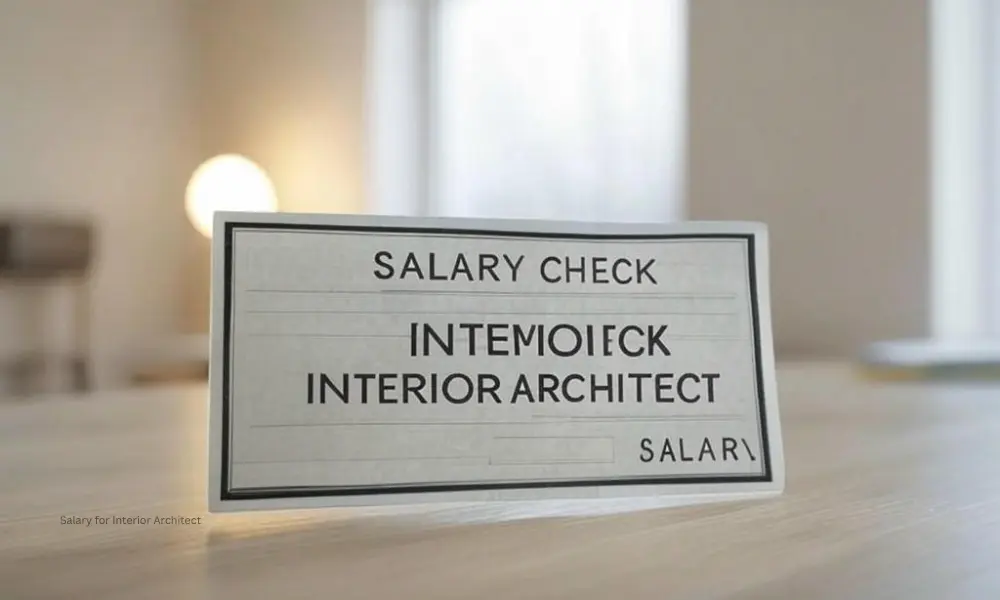Salary for Interior Architect: What to Expect in 2025

Salary for Interior Architect Let’s cut to the chase—you’re here to find out how much interior architects really make in 2025, right? Whether you’re a student considering this career or a professional exploring your earning potential, this guide gives you the full picture. And yes, we’ll break it down country by country, level by level, and skill by skill. Let’s dive in!
Table of Contents
What is an Interior Architect?
Role Overview
An interior architect bridges the gap between architectural structure and interior design. They plan, design, and execute functional, safe, and aesthetically pleasing interior spaces—often working closely with engineers, contractors, and designers.
How It Differs from Interior Design and Architecture
While interior designers focus more on aesthetics and decor, interior architects handle structural and spatial planning—like relocating walls, adjusting layouts, and integrating systems like HVAC and lighting.
Average Salary for Interior Architect in 2025
Entry-Level Salary
Fresh out of school? You can expect to earn:
- United States: $50,000 – $60,000/year
- UK: £25,000 – £30,000/year
- Pakistan: PKR 45,000 – 70,000/month
Mid-Level Salary
With 3–7 years of experience, salaries increase significantly:
- US: $65,000 – $85,000/year
- UK: £35,000 – £45,000/year
- Pakistan: PKR 100,000 – 200,000/month
Senior-Level or Experienced Architects
Senior professionals, project leads, or those in management roles can earn:
- US: $90,000 – $130,000+/year
- UK: £50,000 – £70,000+/year
- Pakistan: PKR 250,000 – 400,000+/month
Salary by Country
United States
- Average Salary: $78,000/year
- High-Earning Cities: New York, San Francisco, Los Angeles
- Certifications like NCARB or LEED can increase your pay by 10-20%.
United Kingdom
- Average Salary: £38,000/year
- Top Areas: London, Manchester
- Chartered status through RIBA boosts earning potential significantly.
Australia
- Average Salary: AUD $75,000 – $100,000/year
- Interior architects are in demand for commercial and green building projects.
Canada
- Average Salary: CAD $60,000 – $85,000/year
- Urban centers like Toronto and Vancouver pay the highest.
UAE & Middle East
- Average Salary: AED 12,000 – 22,000/month
- High-end luxury projects in Dubai and Abu Dhabi offer strong incentives.
Pakistan & South Asia
- Average Salary: PKR 80,000 – 250,000/month
- Salaries vary greatly depending on firm reputation and project scale.
Factors Influencing Interior Architect Salaries
Location
Big cities pay more due to higher cost of living and larger projects. Remote regions typically offer lower salaries.
Education & Certifications
A Bachelor’s or Master’s degree is standard. Extra certifications (like LEED, WELL, or NCARB) significantly boost market value.
Experience & Portfolio
The better your portfolio, the higher your value. Employers and clients pay for proof of success.
Company Type & Industry Sector
- Architecture Firms: Steady pay and structured growth
- Real Estate Developers: Higher bonuses, but project-based work
- Freelance: Variable income but more flexibility
Freelance vs Full-Time Interior Architects
Income Potential
Freelancers can charge per project or hourly. Rates vary:
- US Freelance Rate: $50 – $150/hour
- Pakistan Freelance Rate: PKR 2,000 – 10,000/hour
Top-tier freelancers may out-earn salaried professionals.
Flexibility & Job Security
Freelancing offers freedom but lacks stability. Full-time roles bring benefits, promotions, and consistent income.
Specializations that Boost Earnings
Sustainable Design
Eco-friendly architecture is booming. Green-certified professionals are in demand and command higher pay.
Hospitality & Commercial Interiors
Restaurants, hotels, and offices offer high budgets and frequent remodeling projects—great for long-term income.
Healthcare & Institutional Projects
These require specialized knowledge and carry long-term contracts—stable and lucrative.
Job Outlook and Growth Opportunities
Demand Trends Globally
As urbanization grows, so does demand for interior architects—especially in luxury, sustainable, and smart design sectors.
Remote Work & Hybrid Roles
Many firms now allow remote design collaboration, opening international job opportunities.
Tips to Increase Your Salary as an Interior Architect
Build a Strong Portfolio
Showcase diverse projects—residential, commercial, and sustainable.
Learn Software & Tools
Master AutoCAD, Revit, SketchUp, Rhino, and rendering software like Lumion or Enscape.
Networking and Professional Development
Attend industry events, join architecture groups, and stay current with trends to stand out.
Common Myths About Interior Architect Salaries
- “Interior architects don’t earn as much as regular architects.”
False. Specialized skills often mean equal or higher pay. - “Freelancers can’t make consistent income.”
With the right clients and marketing, they can often earn more. - “You need to work in big cities to earn well.”
Remote roles and niche specializations change that game.
Conclusion
If you’re considering a career in interior architecture, the salary potential in 2025 is promising—especially if you bring the right mix of skills, experience, and certifications. From flexible freelancing to high-paying roles in luxury and sustainable design, the opportunities are there for those ready to take them. Whether you’re just starting or already in the field, now’s the time to level up and claim your worth.
FAQs
1. What is the average salary for an interior architect in the US?
Around $78,000 per year, with experienced professionals earning up to $130,000+.
2. Is freelancing as an interior architect profitable?
Yes, top freelancers often earn more than salaried professionals, especially with a strong portfolio and client base.
3. What skills increase an interior architect’s salary?
Mastery in software tools, sustainable design certifications, and experience in commercial projects.
4. Which countries offer the highest pay for interior architects?
The US, UK, Australia, and UAE lead in terms of salary potential.
5. Can interior architects work remotely?
Yes, many firms now offer remote or hybrid roles, especially for design and planning stages.






